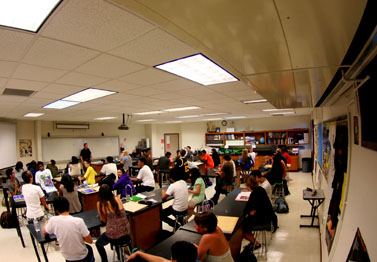 Classes in high demand force teachers to accept more students
Classes in high demand force teachers to accept more students
In the Physics classroom B105, designed to accommodate 32 students, teacher Jeff Trevarthen had to make room for the 40 students that entered his classroom on the first day of school. Twice.
And then one more time in B106. For AP Environmental Science.
 “It was hectic trying to find places for people to sit,” Trevarthen said. “It feels like people are right on top of you because there are that many people in here sometimes.”
“It was hectic trying to find places for people to sit,” Trevarthen said. “It feels like people are right on top of you because there are that many people in here sometimes.”
Trevarthen, who has taught at MVHS for nine years, has never had a class so large before. This year, his second and fourth period classes are overflowing with new students.
“We barely have enough desks to go around. I’ve got people sitting in the teacher desk in my physics classes,” Trevathen said. “The amount of resources we have [is not enough], especially because these are lab classes [and] we don’t have enough supplies to go around for everybody. So the groups, instead of being two to three people, end up being five to six, which is too many.”
Spanish teacher Maria Coughlin explains that having too many students prevents her from providing each student with as much attention and personalized instruction as they may need. This year, Coughlin has two classes of AP Spanish students, each brimming with 40 students as well.
“It makes [teaching] a little more difficult, particularly AP classes,” Coughlin said.”College Board recommends teachers have 20 students in the class as the average, so when you have more than 20 students, it takes twice as long to get the [corrected] materials back to students.”
Even the students admit that the overcrowding is a little extreme. Senior Grace Huang, who is in Coughlin’s fifth period AP Spanish class, personally dislikes the large crowds in her class.
“In fifth period, if you want to talk, you have to compete a little bit to be able to,” Huang said. “I think it was a negative change. I mean, its really hard for the teachers to have to remember more names and [as a student], you don’t feel comfortable in that environment.”
With limited resources and even more limited time, teachers have been struggling to keep up with the increasing flow of students. Both teachers propose making more classes in order to maximize the attention that each students gets; however, they understand the school and the district are trying their best to place students in their selected classes.
“My solution would be to make three or four classes out of it,” Coughlin said. “[But it won’t happen unless] somebody gave [the school] more money, or if the state finds out that it was suddenly rich.”








